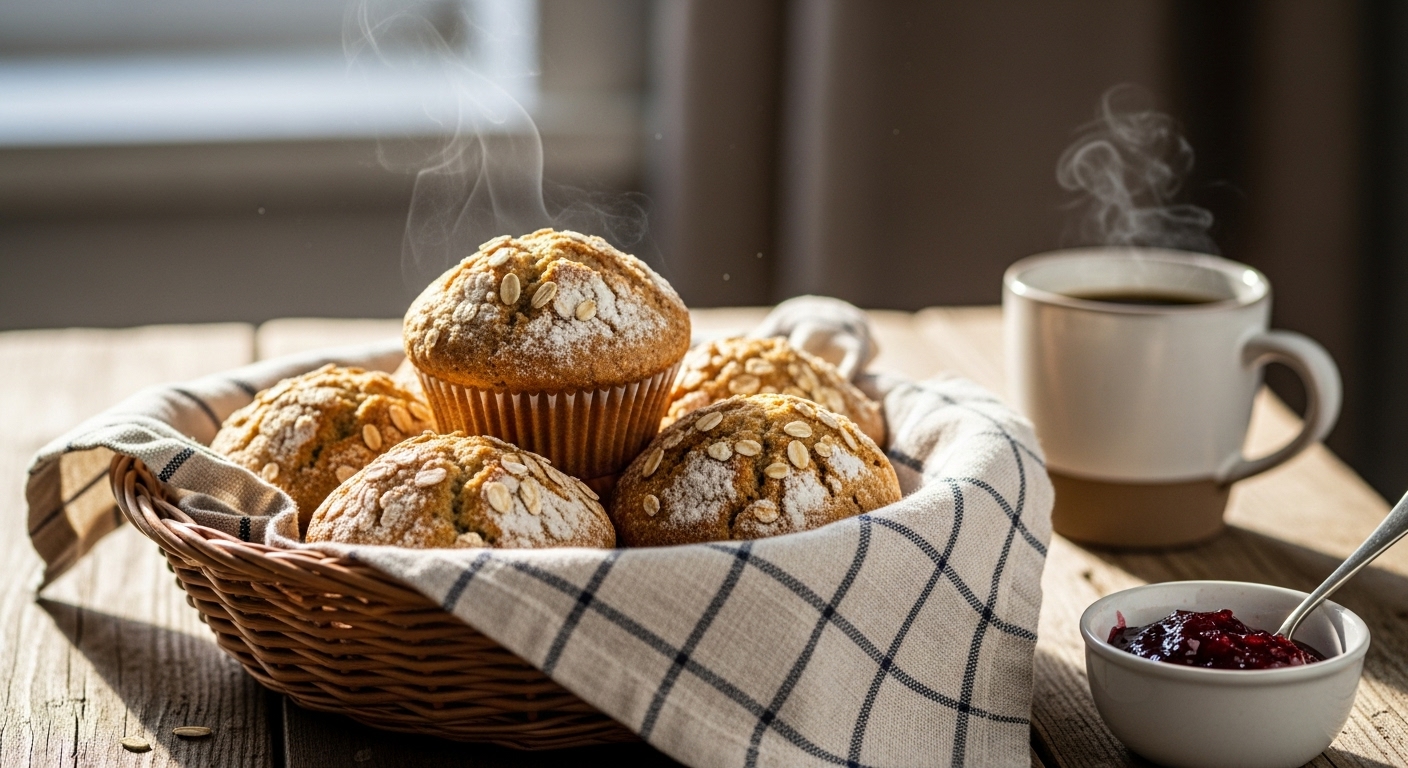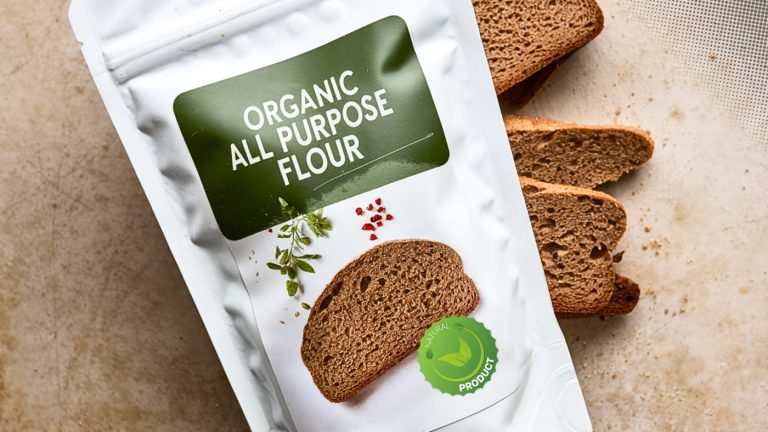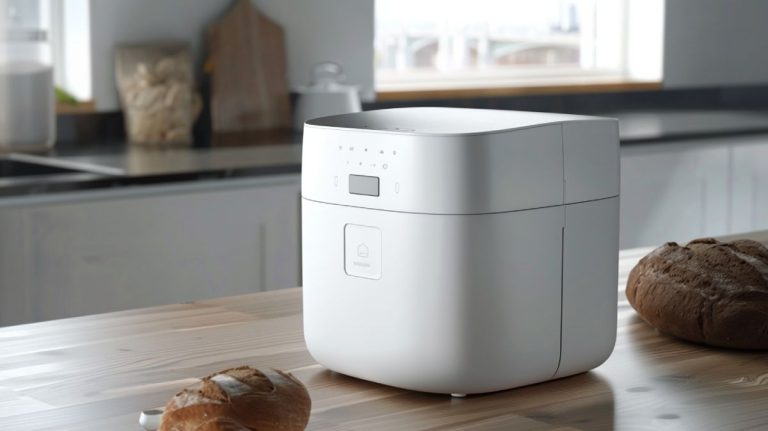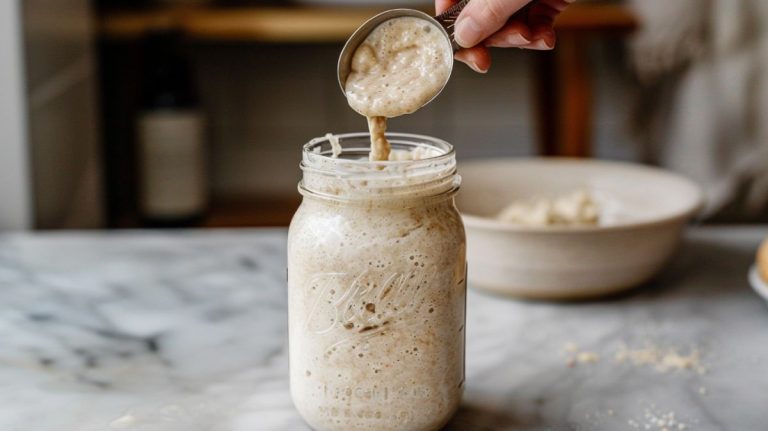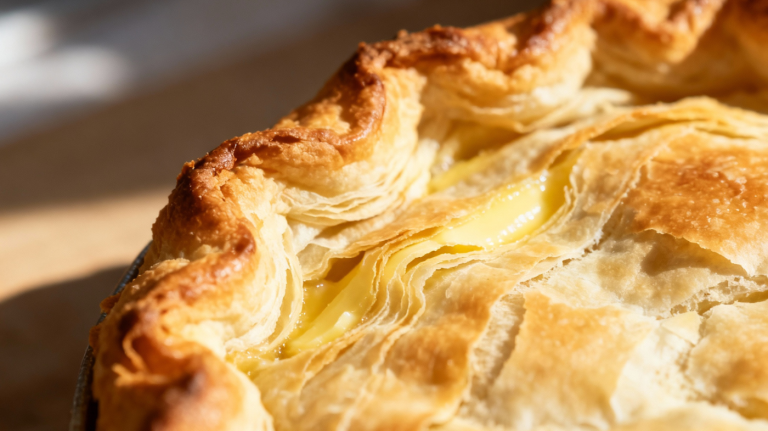Whole Wheat Sourdough Discard Recipes: Quick & Tasty
You can easily turn your whole wheat sourdough discard into delicious, fiber-rich breads, crackers, or savory muffins that reduce waste and boost nutrition.
Just adjust hydration levels since whole wheat absorbs more water, then use techniques like folding to develop gluten and enhance texture.
Adding simple flavors like honey or herbs can elevate your bake. With the right handling and storage, you’ll create moist, tangy treats perfect for any meal.
To explore more tips and recipes, keep going.
Key Takeaways
- Whole wheat sourdough discard is nutrient-rich, enhancing fiber, protein, and mineral content while improving digestibility through fermentation.
- Adjust hydration between 70% and 90% for whole wheat discard dough to ensure optimal moisture and texture.
- Use stretch-and-fold or slap-and-fold techniques for handling sticky, high-hydration whole wheat sourdough discard doughs.
- Repurpose discard into savory recipes such as crackers, fritters, and quick breads to minimize waste and add flavor.
- Store discard refrigerated and use within 1–2 weeks for best freshness and baking results.
Popular Whole Wheat Sourdough Discard Recipe Options
| Recipe Type | Key Ingredients | Difficulty Level | Prep Time | Best For |
|---|---|---|---|---|
| Whole Wheat Bread | Discard, whole wheat flour, water, salt, olive oil | Intermediate | 4-6 hours | Hearty sandwiches, daily meals |
| Crispy Crackers | Discard, flour, olive oil, herbs and spices | Easy | 30-45 minutes | Quick snacks, appetizers |
| Savory Muffins | Discard, grated vegetables, cheese, whole wheat flour | Easy | 25-35 minutes | Meal prep, breakfast on-the-go |
| Banana Bread | Discard, bananas, honey, whole wheat flour, eggs | Easy | 1 hour | Sweet treats, breakfast |
| Flatbreads | Discard, flour, salt, olive oil | Easy | 20-30 minutes | Quick dinners, wraps |
| Oatmeal Cookies | Discard, oats, cinnamon, honey or maple syrup | Easy | 30 minutes | Desserts, healthy snacks |
| Vegetable Fritters | Discard, shredded veggies, eggs, seasonings | Easy | 20 minutes | Light meals, side dishes |
Benefits of Using Whole Wheat Sourdough Discard

While often overlooked, whole wheat sourdough discard offers impressive nutritional benefits that make it more than just leftover starter.
It’s packed with fiber, protein, B vitamins like folate and niacin, plus essential minerals such as iron and magnesium.
Thanks to fermentation, these nutrients become more bioavailable as phytic acid breaks down, improving your body’s absorption. Using whole wheat sourdough discard also supports sustainable cooking by reducing waste and promoting eco-friendly practices.
Fermentation breaks down phytic acid, enhancing nutrient absorption for better health benefits.
You’ll also find antioxidants and prebiotic fibers that nourish your gut bacteria, supporting digestion and overall health.
The natural fermentation process reduces gluten content and improves digestibility, making it gentler on your stomach compared to regular wheat products. Additionally, sourdough discard introduces probiotics that contribute to a healthy gut microbiome, supporting immune function and reducing inflammation.
Plus, the discard remains low in saturated fat and cholesterol-free.
Using it not only boosts nutrition but also helps reduce food waste, turning what’s usually tossed into a valuable ingredient for your kitchen.
Essential Ingredients for Whole Wheat Discard Breads
When you’re baking whole wheat sourdough discard breads, your choice of flour really sets the stage for the flavor and texture of your loaf. It’s like the base of a delicious cake – you need a good foundation!
And let’s not forget about hydration; it plays a crucial role in how your dough comes together. You want to find that sweet spot with the water, balancing it just right to create a dough that’s moist but still manageable. Using whole wheat flour with ~12.5% protein helps achieve a balanced texture and flavor in your bread.
Oh, and if you want to take things up a notch, think about adding some flavor enhancers! Ingredients like honey or olive oil can really elevate the taste and freshness of your bread. It’s those little touches that make a big difference, right?
Key Flour Choices
Choosing the right flours plays a crucial role in crafting delicious whole wheat sourdough discard breads, as each type brings unique flavors and textures to your loaf.
Whole wheat flour offers a nutty flavor and coarser texture, while bread flour strengthens gluten for better structure. Flours with high protein content are especially beneficial for achieving a chewy crust and airy crumb.
You can lighten your bread by mixing in all-purpose flour, and rye flour adds a distinctive, complex taste.
Opting for stone-milled flour enhances nutrient content and enriches flavor compared to roller-milled options.
Experiment with flour ratios; 100% whole wheat yields a dense, hearty loaf, whereas blends balance texture and rise.
Combining flours lets you tailor your bread’s crumb and flavor, ensuring each bake suits your preferences perfectly.
Using sourdough discard made from any whole wheat or white starter can add rich, nuanced flavor and reduce waste in your baking.
Hydration and Liquids
Because whole wheat flour absorbs more water than refined flours, understanding hydration and the role of liquids is essential for baking successful sourdough discard breads. Hydration is the ratio of water to flour, usually between 70% and 90% for sourdough, influencing crumb openness and crust texture.
Precise measurement of all water and flour, including that in your starter, ensures accurate calculation of dough hydration for consistent results.
Your sourdough starter also adds water and flour, affecting overall hydration. Adjust liquids based on flour type, environment, and desired bread characteristics. Whole wheat flour typically requires 5-15% higher hydration compared to bread flour to achieve the best dough consistency.
Keep these tips in mind:
- Use enough water to fully hydrate the bran and germ for a tender crumb.
- Consider starter hydration when calculating total dough hydration.
- Employ techniques like autolyse to help the flour absorb water evenly, improving dough consistency.
Mastering hydration and liquids lets you craft moist, flavorful whole wheat breads every time, while also optimizing fermentation time and enhancing flavor development.
Flavor Enhancers
Mastering hydration sets a solid foundation, but the flavors you build into your whole wheat discard bread really bring it to life.
Sweeteners like maple syrup or honey not only add natural sweetness but enhance the nutty tones and aid yeast activity, improving rise and crumb texture. Using honey influences dough hydration and flavor, so measuring carefully helps maintain the right dough consistency. Maple syrup offers a vegan option, while honey helps with browning and moisture retention, contributing to a crispy, golden crust.
Fats, especially organic olive oil, enrich mouthfeel and keep your loaf fresh longer by slowing staling.
Salt is essential too, controlling fermentation and strengthening gluten while enhancing taste.
You can experiment with spices or sweet add-ins like cinnamon or chocolate chips to deepen flavor.
Step-by-Step Preparation Techniques
First things first, you’ll want to nail down your mixing and hydration techniques. This is crucial for that perfect dough consistency. For instance, using a silicone spatula for initial mixing and then your hands for kneading ensures the dough achieves the right texture.
Using a digital baking scale can help you measure ingredients precisely for consistent results. Once you’ve got that down, it’s all about the kneading and folding. These techniques really help build the strength and structure of your dough.
Now, let’s talk about proofing and baking. Timing is everything here!
Getting it just right is essential for developing those amazing flavors and textures in your whole wheat sourdough. You can choose to proof your dough at room temperature or opt for a cold proof in the fridge, with each method imparting different flavor profiles due to the slow fermentation.
Mixing and Hydration Tips
When preparing whole wheat sourdough, starting with the right mixing and hydration techniques sets the foundation for a well-structured dough.
Begin by mixing flour and water during an autolyse phase, which hydrates the flour and helps develop gluten. Incorporate your levain by breaking it into small pieces and mixing thoroughly by hand or with a stand mixer on low speed.
Aim for a hydration level around 85-90%, as whole wheat flour absorbs more water and creates a sticky but manageable dough. Use cold water to control fermentation and prevent over-proofing.
Keep these tips in mind:
Rest the dough after mixing to improve hydration and gluten relaxation.
Adjust hydration based on your specific flour’s absorption.
Use large bowls and silicone spatulas for easier handling and mixing.
Regular feeding with fresh flour and water rejuvenates the microbial community, stimulating fermentation and enhancing flavor and texture.
Kneading and Folding Methods
After mixing and hydrating your whole wheat sourdough discard dough, the next step focuses on kneading and folding to build strength and structure.
You can choose traditional hand kneading, the stretch and fold method, or the slap and fold technique, depending on dough hydration and texture. Kneading develops gluten by stretching and folding, while folding during bulk fermentation gently strengthens the dough without overworking it. Proper technique during these stages also helps maintain the unique flavor of sourdough.
Whole wheat flour typically requires increased water absorption, so adjusting hydration during kneading can improve dough consistency and final texture.
| Technique | Best For |
|---|---|
| Hand Kneading | Lower hydration, firm dough |
| Stretch & Fold | Sticky, dense whole wheat |
| Slap & Fold | High hydration (>78%) dough |
| Bulk Fermentation Folding | Enhances dough strength gradually |
Frequent wetting of hands prevents sticking. Remember to rest between folds for gluten relaxation and hydration.
Proofing and Baking Timing
Although proofing and baking timing may seem straightforward, mastering these steps is essential to unlocking the full potential of your whole wheat sourdough discard dough.
You’ll want to control proofing temperature between 24°–27°C to avoid overproofing and maintain dough stability. Proofing is the crucial final fermentation step that allows your dough to develop acidity and flavor before baking. Using a gentle folding technique during proofing can help maintain dough structure and prevent overworking.
Bulk fermentation typically lasts 3 to 4 hours with three stretch-and-fold sets spaced out to build gluten without degassing.
For the final proof, opt for 30 minutes to 4 hours at room temperature or a longer cold proof of 12-15 hours in the fridge for enhanced flavor. Chilling the dough during this stage also helps in flavor melding and improves texture.
Bake immediately after proofing to capture ideal oven spring and crumb texture.
- Monitor dough rise: a 30-40% volume increase signals readiness.
- Use gentle finger press: a partial spring-back shows proper proofing.
- Cover dough to prevent drying during proofing.
Savory Recipes Featuring Whole Wheat Discard
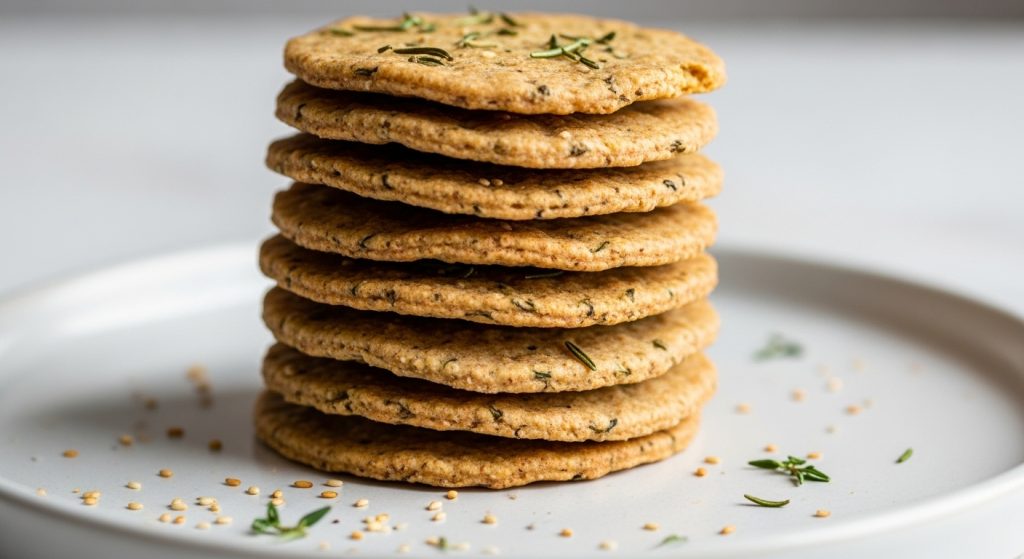
Because whole wheat sourdough discard carries rich flavor and natural fermentation, you can transform it into a variety of savory dishes that are both delicious and nutritious.
Use it to make quick breads and rolls like preservative-free burger buns or soft hot dog rolls that add hearty texture and robust taste to your sandwiches. Many recipes combine discard with commercial yeast for a reliable rise and fluffy texture.
You can also whip up crisp crackers or flatbreads, customizing with herbs, cheese, or even pumpkin puree for nutrient-packed snacks.
For vegetable lovers, try mixing discard with grated veggies to create flavorful fritters or savory muffins, perfect for meal prep or a light meal.
These recipes are easy, waste-reducing, and require minimal active time, letting you enjoy wholesome, homemade savory treats bursting with sourdough’s unique tang.
Sweet and Savory Baking Ideas With Discard

Savory dishes showcase the boldness of whole wheat sourdough discard, but you can also explore a wide range of sweet and savory baked goods that highlight its versatility. Using a quality proofing basket can greatly improve the texture and rise of your sourdough bread, complementing your baking process.
Using discard in your baking adds moisture, depth, and a subtle tang, enhancing flavors beautifully. Whether you’re craving something sweet or a savory snack, discard adapts well. It is important to note that sourdough discard should be stored in the fridge and used within about 2 weeks to maintain its quality.
Try these ideas to get started:
Banana bread: Moist with a glossy finish, perfect for breakfast or snacks.
Oatmeal cookies: Chewy with cinnamon and raisins, offering complex flavor.
Scones: Tender texture, easily customized for sweet or savory tastes.
Incorporating discard elevates your baking, making each treat uniquely flavorful and satisfying. Using natural rattan baskets during proofing can enhance dough structure and final bread quality.
Tips for Enhancing Flavor and Texture
When you want to get the most from your whole wheat sourdough discard, paying attention to both flavor and texture can transform your baked goods.
To boost flavor, try adding a touch of maple syrup or honey, which activate yeast and bring natural sweetness.
Balance acidity by discarding regularly; fresh discard offers a mild yeasty note, while older discard adds tangy depth. It is best to use discard within 1 week to avoid overly acidic flavors that can affect your bake.
For texture, choose hard red wheat flour to improve structure and mix your dough by hand to develop gluten.
Adjust hydration carefully, as discard’s moisture varies. Incorporate leavening agents like baking soda for lighter crumb, and don’t skip resting time; it softens and evens texture.
With these tips, you’ll craft more flavorful, tender breads that showcase the best of your discard.
Frequently Asked Questions
How Long Can Whole Wheat Sourdough Discard Be Stored Before Use?
You can store whole wheat sourdough discard in the refrigerator for up to two weeks, but it’s best to use it within the first week to enjoy ideal flavor.
If you want to keep it longer, freezing is a great option and can preserve it indefinitely.
Avoid leaving it at room temperature for long since it ferments quickly and gets overly sour.
Always use airtight containers to keep it fresh and safe.
Can Whole Wheat Sourdough Discard Be Frozen for Later Recipes?
Absolutely, you can freeze whole wheat sourdough discard, like capturing a snapshot of its lively bubbles in time.
Before freezing, feed it to peak activity, then portion and freeze solidly to lock in its energy.
When you’re ready to bake, thaw gently and feed it again to wake up those microbes.
This way, your discard stays fresh and ready, letting you whip up delicious recipes anytime without waste or fuss.
What Is the Best Way to Revive Dried Sourdough Discard?
To revive dried sourdough discard, start by mixing 5-10 grams with lukewarm water until it softens.
Then, stir in equal parts flour to create a paste.
Let it rest at room temperature, feeding it daily with a 1:1:1 ratio of starter, flour, and water.
Once bubbles appear, feed twice a day to boost activity.
Keep it loosely covered, avoid direct sunlight, and maintain consistent warmth for the best results.
How Does Whole Wheat Discard Affect the Shelf Life of Baked Goods?
Whole wheat discard impacts your baked goods’ shelf life by increasing acidity, which can slow spoilage and extend freshness. However, its bran and natural oils might speed rancidity if stored too long.
The higher fiber retains moisture but may also cause faster staling due to enzyme activity breaking down starches. To maximize shelf life, use discard fresh or refrigerated.
Avoid overly acidic or fermented discard that can degrade texture and shorten freshness.
Are There Any Common Allergens in Whole Wheat Sourdough Discard Recipes?
You might be surprised to learn that yes, common allergens like wheat (gluten), eggs, dairy, and soy often show up in these recipes.
Since wheat is the base, gluten is always present.
Eggs and dairy sneak in through added ingredients like butter or milk, while soy sometimes appears in vegan substitutions.
If you have allergies, you’ll want to check recipes carefully and consider swaps like plant-based milks or egg replacers to stay safe.
Never Waste Sourdough Discard Again
By embracing whole wheat sourdough discard, you’re turning what might feel like waste into a kitchen treasure.
These recipes not only reduce food waste but also add rich flavors and wholesome nutrition to your baking.
With the right ingredients and techniques, you’ll find that a little sourdough discard goes a long way, proving that sometimes, the best things come in small packages.

